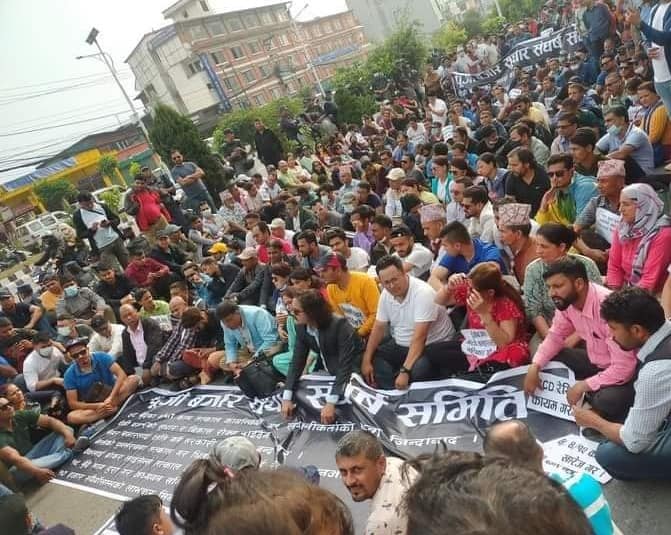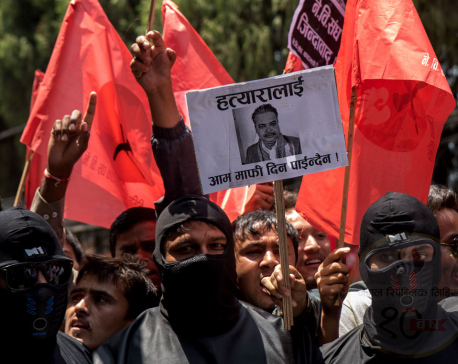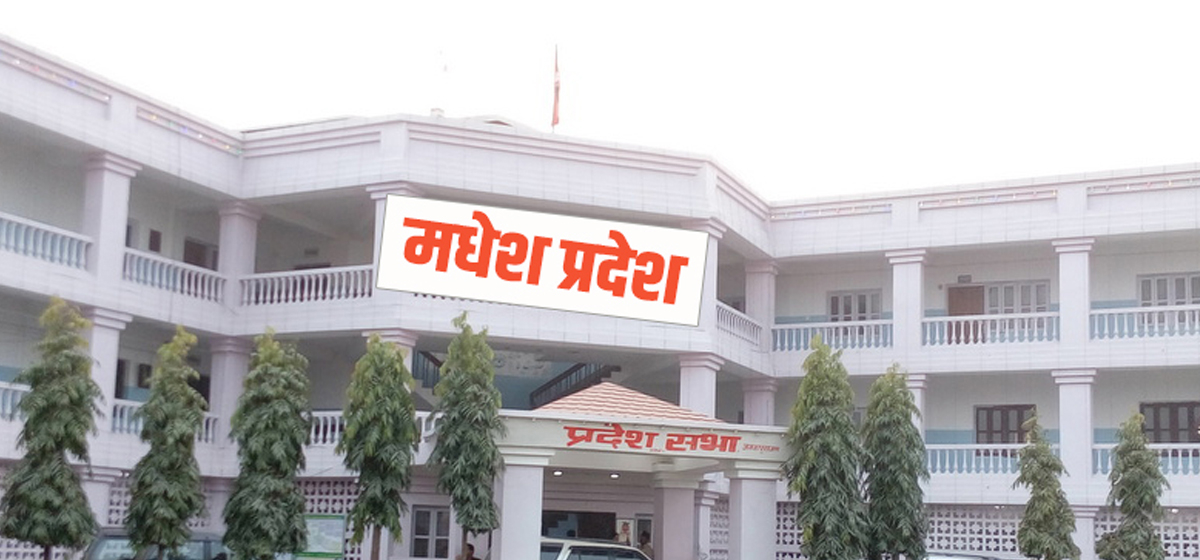
OR
#Stock Market in Bearish Trend
Investors demand effective measures to uplift market as adverse macroeconomic indicators take down Nepse index by large
Published On: June 20, 2022 05:39 AM NPT By: Moktsya Poudyal

KATHMANDU, June 20: Nepal Stock Exchange (Nepse) is currently in what experts call a “bearish trend” mainly triggered by the uncertainties raised by the worsening performance of the country’s macroeconomic indicators.
The stock market is considered a mirror to reflect the economic position of a country. The poor health of the stock market is often taken as the beginning of a recession. Amid increasing concern on whether the Nepali economy has also rallied from a recession, the Nepse index has fallen by notable points from what was seen 10 months ago. Amidst post-pandemic impacts, rising inflation, shrinking foreign reserves and a turbulent international environment, experts speculate on the cause of the declining stock exchange and its possible effect on the economy.
Less than 10 months ago, on August 18, 2021, Nepse closed at an all-time high at 3,198.60 points. On Sunday, the secondary market closed with its index at 1,934.11, a decrease of 39.5 percent from an all-time high value. Analysts including Santosh Mainali, President of the Stockbroker Association of Nepal, and Neeraj Giri, Former Executive Director of the Securities Board of Nepal (Sebon), agree that the bearish trend of the stock exchange has been due to liquidity crunch and soaring interest rate of the banks.
“The economy has long been facing a liquidity problem,” says Mainali. The records with Nepal Rastra Bank (NRB) show that the country’s banking sector has been in a massive liquidity crunch for the past few months.
According to the monetary policy announced by NRB for the fiscal year 2021/22, banks and financial institutions (BFIs) are required to limit the Credit-Deposit (CD) ratio to a maximum of 90 per cent by the end of the current fiscal year. The CD ratio reveals how much a bank has lent out of its collected deposits. Due to excessive lending during the first few months of the current fiscal year, banks have been under tremendous pressure to manage their CD ratio, which has also adversely affected their loanable fund. “Banks have now started emphasizing on recovering loans rather than giving them out as the fiscal year approaches its end,” comments Mainali.
Consequently, the interest rates are rising. “The share market is inversely proportional to interest rates,” says Giri who served the regulatory body and recently retired.
Similarly, Mainali states that an increase in interest rates raises the costs of taking loans for those who invest in stocks through loans. “It makes depositing savings a more attractive option, leaving fewer amounts to inject in the market.”
Policy measures employed by NRB is another factor influential in the state of the stock exchange. The central bank, as a part of its monetary policy for the fiscal year 2021/22, had constricted share-based payment, limiting an entity or individual to take marginal loans — loans taken to invest in stocks by using the existing shares as collateral — of up to Rs 40 million from one BFI and Rs 120 million in total. Many investors have had to sell their shares to reduce their loan size to the limit. “The loan limit has increased selling pressure,”adds Mainali.
When the stock market was soaring a year ago, the central bank issued a directive preventing BFIs from investing in the stocks of microfinance institutions and made it obligatory for them to hold the shares they bought for at least a year. The officials of the bank had then claimed that the measures were intended to avert the overexposure of BFIs in share trading. However, the move has also prevented large sums of money from circulating in the stock market. It has decreased demand in the market when selling pressure has increased, propelling the prices to plunge.
“These policies that NRB has been using currently are the measures that were introduced when the index was around 3000 points — when the market was at its peak. Circumstances have changed since then and so should the policies as well,” Mainali adds.
In addition to this, experts see the rising inflation in the country to be a reason for the bearish trend. As per the publications made available by NRB, the year-on-year consumer price inflation reached 7.87 per cent in the tenth month of the current fiscal year from 3.65 per cent a year ago. “People will only invest if they can save from their income which has been less likely given they are facing difficulties in affording their usual expenses,” says Mainali.
The global share markets have also been dwindling as the Russia-Ukraine conflict is heading towards its peak. The authorities concerned should not take it as a mere excuse, but rather as a need to prompt in the line to safeguard the interests of a large number of investors.
“Overall there is a weak incentive for investors to invest in the stock market,” comments Mainali about NEPSE’s current state. He believes that the government should intervene to motivate the investors. “But the government must enact to increase the demand. Taking companies that have more than Rs 1 billion as capital to public limited, and letting Non-Resident Nepalis (NRNs) to invest in the stock market could help increase demand.”
However, Giri believes that besides the liquidity crunch and the rise in interest rates, the trend is also caused by the exit of investors from the market who had entered the market after the onset of the COVID-19 pandemic and the mobility restrictions. The number of Demat accounts in the fiscal year 2020/21 alone increased by over 1.5 million while it has reached over 5.2 million as of now. Similarly, the users of Meroshare, an online platform that allows investors to buy and sell stocks of companies listed in Nepse, have also crossed 3.78 million.
“When people could not go out during lockdown, trading in the stock market was still possible through online means. So many people entered the market,” says Giri. “Now that the pandemic has lessened in severity and restrictions have been removed, those who had entered the market, are now quitting investing after booking their profits. The remaining investors went into a panic as the market declined. They began selling their shares which have aggravated the situation.”
Giri, commenting on the impacts of NRB’s policies, said though different people had suggested that the central bank’s policies caused the decline of the stock market, a certain conclusion cannot be yet drawn as no relevant studies have been conducted in this regard.
The fall in prices has led to losses of billions of rupees for investors. Margin calls are increasing. Margin calls occur when the value of securities in a brokerage account falls below a certain level (known as the maintenance margin), requiring the account holder to deposit additional cash/securities to meet the margin requirements.
Stockholders who had taken margin loans to invest in stocks have been facing hardship in paying back the loans when the value of their equity is decreasing. Mainali feels that if the government, NRB and the SEBON do not work in coordination to rescue the share market, the bearish trend can have a severe impact on the economy. “The real estate market is also in a slump, all of our business is import oriented and the government has restricted imports. A slump in the share market in such conditions would increase illiquidity in the economy. This is a serious threat,” says Mainali.
On the other hand, Giri views the bearish trend to be yet another part of the cyclic nature of the stock market. He opines that the performance of the listed companies is at the core of the health of the share market. “The bearish trend may not continue for long. A new fiscal year is to begin and companies would have to publish their annual reports. Their positive annual reports could encourage people to invest in the share market. It will boost the confidence of the investors,” he added.
You May Like This

PHOTOS: Farmers continue demonstration in capital with ploughs and canes, demanding clearance of dues
KATHMANDU: After having been deceived time and again by the sugar mills and even by the government, sugarcane farmers from... Read More...

Republica Morning Brief : Sept 29
Minister for Foreign Affairs Pradeep Gyawali on Monday said the risk of novel coronavirus disease (COVID-19) in the country is... Read More...

IN PICTURES: Nepal Student Union's protest against Deuba, inflation
KATHMANDU, May 25: The Nepal Students' Union which had gathered at Exhibition Road to protest against inflation took their time... Read More...







Just In
- Forest fire destroys 13 houses in Khotang
- First meeting of Nepal-China aid projects concludes
- Lungeli appointed as Minister for Labor and Transport in Madhesh province govt
- Bus knocks down a pilgrim to death in Chitwan
- One killed in tractor-hit
- Karnali Chief Minister Kandel to seek vote of confidence today
- Chain for Change organizes ‘Project Wings to Dreams’ orientation event for inclusive education
- Gold price decreases by Rs 200 per tola today












Leave A Comment